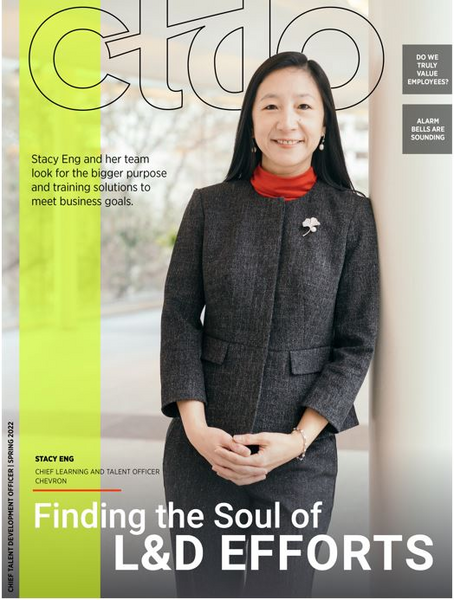ATD Blog
Building Chevron’s Leadership Pipeline
Mon Jun 13 2022


CTDO Magazine recently spoke with Stacy Eng, chief learning and talent officer for Chevron, about the role talent development plays in helping organizations achieve business results. A critical aspect of any high-performing company is how it develops its leaders. During our discussion, she made clear that nurturing leaders is a priority for Chevron. Here’s more about the company’s leadership development efforts.
CTDO: Talent development at Chevron requires continuous upskilling and reskilling of its technical workforce. How does leadership development fit into your programming?
Eng: Leadership development is crucial to our success. Whether you have a title of supervisor or manager doesn't matter; you have to lead in our company.
So, Chevron has multiple development opportunities for leaders, from early career talent to senior executives. And all the offerings along the leadership development continuum, which includes assessments, asynchronous learning modules, self-paced learning materials, virtual webinars, and coaching, follow Chevron’s We Lead model.
We Lead offers four dimensions of behaviors and competencies that are critical for our leaders. The first dimension is all about how leaders can align and inspire. In other words, how can leaders motivate, influence, and inspire others. The second piece concentrates on building relationships. It advises leaders on team dynamics and culture and how to effectively operate in a matrix environment.
Instilling a learning mindset is the third element of the model. A goal of Chevron leaders is to be a lifelong learner; they also must aim to continuously develop others. We believe that supervisors and managers have a responsibility to grow the capabilities of their teams and the organization.
And the last dimension is all about results. How do leaders set expectations and remove barriers for the organization? How do they support innovation and a sense of problem-solving entrepreneurship?
CTDO: How does Chevron determine who receives leadership development?
Eng: One way is our Aspiring Leaders program. These are individual contributors who are interested in leading but may not be a supervisor yet. Curriculum is focused on developing their leadership or managerial capabilities before they even become a manager. What’s interesting is that employees can self-nominate themselves to be a part of this learning path, or managers can suggest influencers on their teams who show leadership potential. If they have that personal aspiration to lead, we want to support them.
We also have an Emerging Leaders program. These are employees who are first-time supervisors or early in their managerial roles at Chevron. The learning path for this program focuses on developing effective managing skills like coaching, giving feedback, and delegating, among others.
A third learning path centers on those who are already leading large functions within Chevron. Learning experiences and content for this group focuses on building capabilities like setting strategy and leading innovation. We want these leaders to be able to do everything from drive the company’s vision to share inspirational storytelling among their teams.
In addition to learning paths that are based on specific career milestones, Chevron has leadership development programs that feature diversity and inclusion. For example, its Global Women's Leadership Development Program focuses on developing a pipeline of female mid-level leaders in different markets. There are similar programs to develop leaders among the company’s African American, Asian American, and Latino and Latina populations. Highlights for these programs are how participants come together as cohorts to discuss and learn about career planning, signature presence, stakeholder management, and so on.
CTDO: Can you discuss what some of the learning activities look like?
Eng: Right now, the bulk of our programming is blended learning. We typically start with self-paced learning assets, like articles or e-learning. Pre-pandemic we had in-person classes, but we’ve converted those to various virtual webinars and online group exercises. Then, we also bring together learners into a virtual learning space as cohorts to discuss key topics and share their learnings.
And it all starts with a leadership assessment. The assessment is important because it helps participants identify the specific leadership capabilities that they need to focus on from a development planning perspective.
Coaching is another piece of leadership development. For example, participants in the Emerging Leader program receive a coach who works with them to debrief their leadership assessment and create a robust development plan to share with their managers. These coaches are internal experts that we certify for our programs, and employees can pick their own or have one assigned to them.
We also use external, third-party coaches for or more senior and mid-level executives. These are professional coaches who are familiar with Chevron and our We Lead model. For example, people taking part in the Global Women's Leadership Development Program are assigned a coach who can offer insights specific to leading at Chevron as well as an objective, outside perspective. Whether internal or external, the goal of adding coaching
